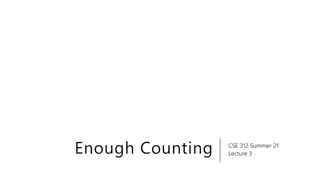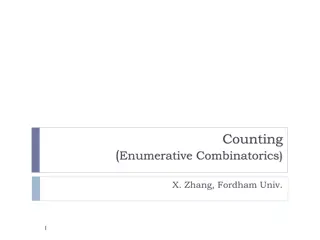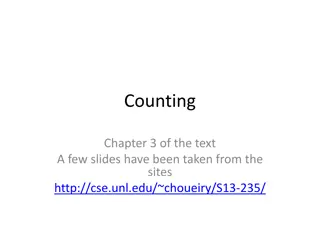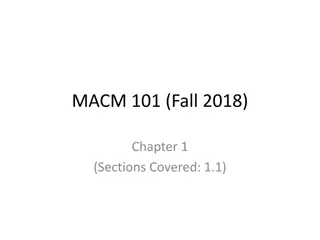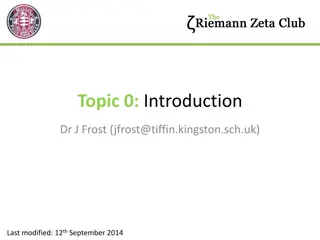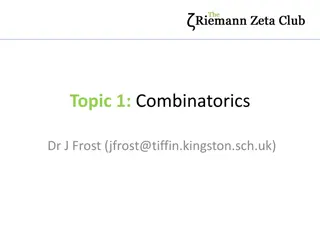Exploring the Twelvefold Way in Combinatorics
The Twelvefold Way in combinatorics classifies enumerative problems related to finite sets, focusing on functions from set N to set X under various conditions like injective or surjective. It considers equivalence relations and orbits under group actions, providing a systematic approach to counting permutations, combinations, multisets, and partitions.
Download Presentation

Please find below an Image/Link to download the presentation.
The content on the website is provided AS IS for your information and personal use only. It may not be sold, licensed, or shared on other websites without obtaining consent from the author. Download presentation by click this link. If you encounter any issues during the download, it is possible that the publisher has removed the file from their server.
E N D
Presentation Transcript
Twelvefold way Surjective functions from N to X, up to a permutation of N
Meaning In combinatorics, the twelvefold way is a systematic classification of 12 related enumerative problems concerning two finite sets, which include the classical problems of counting permutations, combinations, multisets, and partitions either of a set or of a number.
Let N and X be finite sets. Let n = | N | and x = | X | be the cardinality of the sets. Thus N is an n-set, and X is an x-set. The general problem we consider is the enumeration of equivalence classes of functions f : N X
The functions are subject to one of the three following restrictions: F is injective. F is surjective. F is with no condition. a
There are four different equivalence relations which may be defined on the set of functions f from N to X: equality; equality up to a permutation of N; equality up to a permutation of X; equality up to permutations of N and X.
An equivalence class is the orbit of a function f under the group action considered: f, or f Sn, or Sx f, or Sx f Sn, where Snis the symmetric group of N, and Sxis the symmetric group of X.
3 4 = 12!!!
Functions from N to X Injective functions from N to X Injective functions from N to X, up to a permutation of N Functions from N to X, up to a permutation of N Surjective functions from N to X, up to a permutation of N Injective functions from N to X, up to a permutation of X Injective functions from N to X, up to permutations of N and X Surjective functions from N to X, up to a permutation of X Surjective functions from N to X Functions from N to X, up to a permutation of X Surjective functions from N to X, up to permutations of N and X Functions from N to X, up to permutations of N and X
Surjective functions from N to X, up to a permutation of N This case is equivalent to counting multisets with n elements from X, for which each element of X occurs at least once. | | | 1 | N X
Soving the problem The correspondence between functions and multisets is the same as in the previous case(Functions from N to X, up to a permutation of N), and the surjectivity requirement means that all multiplicities are at least one. By decreasing all multiplicities by 1, this reduces to the previous case; since the change decreases the value of n by x, the result is
Another view N 1 2 3 X
Example + + + = 12 a b c d N+ ( , , , a b c d ) , , , a b c d ( are identical)














